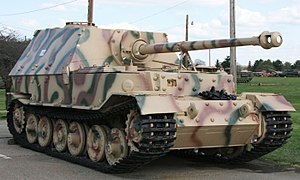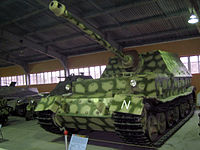| Panzerjäger Tiger (P) | |
|---|---|
 The United States Army Ordnance Museum's restored Elefant. | |
| Type | Heavy tank destroyer |
| Place of origin | Nazi Germany |
| Production history | |
| Designer | Dr. Ferdinand Porsche |
| Designed | 1942–1943 |
| Manufacturer | Porsche AG |
| Produced |
March–May 1943 (modification into Elefant October–November 1943) |
| No. built | 91 |
| Specifications | |
| Mass | 65 tonnes (143,000 lb) |
| Length | 8.14 m (26 ft 8 in) with gun |
| Width | 3.38 m (11 ft 1 in) |
| Height | 2.97 m (9 ft 9 in) |
| Crew | 6 (driver, radio-operator, commander, gunner, two loaders) |
|
| |
| Armor | 200 mm (7.87 in) |
Main armament | 8.8 cm Pak 43/2 L/71, also known as StuK 43/1 |
Secondary armament | 7.92 mm MG 34 machine gun (only Elefant) |
| Engine |
2 × Maybach HL 120 petrol 600 PS (592 hp, 442 kW) |
| Power/weight | 9.23 PS/tonne |
| Suspension | longitudinal torsion-bar |
Operational range |
150 km (93 mi) road 90 km (56 mi) cross-country |
| Maximum speed | 30 kilometres per hour (19 mph) |
The Elefant (German for "elephant") was a Schwerer Panzerjäger ("heavy tank destroyer") of the German Wehrmacht used in small numbers in World War II. It was built in 1943 under the name Ferdinand, after its designer Ferdinand Porsche. In 1944, after modification of the existing vehicles, they were renamed Elefant. The official German designation was Panzerjäger Tiger (P) and the ordnance inventory designation was Sd. Kfz. 184.
Development history[]

Porsche's pre-Elefant, turreted Tiger I prototype
Porsche AG had manufactured about one hundred chassis for their proposal of the Tiger tank, the unsuccessful "Porsche Tiger", in the Nibelungenwerk factory in Sankt Valentin, Austria. Both Henschel and Porsche chassis used the same Krupp-designed turret—the Henschel design having its turret more-or-less centrally located on its hull, with the Porsche design placing the turret much nearer the front of the superstructure. Since the competing Henschel Tiger design was chosen for production, the Porsche chassis were no longer required for the Tiger tank project. It was therefore decided that the Porsche chassis were to be used as the basis of a new heavy tank destroyer, mounting Krupp's newly developed 88 mm Pak 43/2 anti-tank gun. This precise long-range weapon was intended to take out enemy tanks before they reached their own range of effective fire.
Therefore the somewhat ad hoc design, Ferdinand supplanted the previous light tank destroyers, like Marder II and Marder III, in the offensive role. The similar gun was used in the lightly armored Hornisse / Nashorn tank destroyer, built in parallel.
Design[]
Chassis[]
The engines had already been placed in the middle of the hull to accommodate the Krupp-designed turret that both the Porsche and Henschel contenders used for the initial Tiger tank contract, and that placement for the Porsche-designed contender gave room on the Ferdinand for the anti-tank main gun armament at the rear. The gun was mounted in a simple, casemate-style box structure, with slightly sloped sides, on top of this chassis. The driver and radio operator were in a separate compartment at the front. As the engines were placed in the middle, the radio operator and the driver were separated from the rest of the crew and could be addressed only by intercom.
Add-on armor of 100 mm was bolted to the front plates, increasing the plate's thickness to 200 mm and adding another 5 tons of weight.
Drive[]
The two Porsche air cooled engines in each vehicle were replaced by two 300 PS (296 hp; 221 kW) Maybach HL 120 TRM engines. The engines drove electric generators, which in turn powered electric motors connected to the rear sprockets. The electric motors also acted as the vehicle's steering unit. This "petrol-electrical" drive delivered 0.11 km/l off road and 0.15 km/l on road at a maximum speed of 10 km/h off road and 30 km/h on road. Besides the high fuel consumption and the poor performance the drive system was also maintenance-intensive; the sprockets needed to be changed every 500 km. Porsche had experience of this form of petrol-electric transmission extending back to 1901, when he designed a car that used it.
Suspension for the "slack track" equipped Elefant consisted of six twin bogies (three per side) with longitudinal torsion bars, without any overlapping wheels or return rollers. What appears to be two sets of drive sprockets, at either end of the vehicle per side, actually comprises a front sprocket that engaged the track with a drum brake unit built into its hub to act as the track brake, with the electric drive motor at the rear on each side, powering the track's rear drive sprocket.
Armament[]
The vehicle was fitted with an 88 mm Panzerabwehrkanone 43/2 gun. This 71 caliber-long gun had originally been developed as a replacement for the famous 88 mm anti-aircraft gun that had been used against Allied tanks in the Western Desert Campaign. It had a much longer barrel than the L/56 guns, which gave it a higher muzzle velocity. It also fired a different, longer cartridge. These improvements gave the 88 mm L/71 significantly improved armor penetration ability over the earlier 88 mm. Although it lost the competition to the 8.8 cm Flak 41 and never became an anti-aircraft weapon, it was turned into the very successful Pak 43 anti-tank gun.
As fitted, the gun was capable of 25° traverse and a similarly limited elevation.
Production[]
Ninety-one existing "Porsche Tiger" chassis were converted (chassis number 150010 to 150100). The work was completed in just a few months from March to May 1943.
Modification—Elefant[]
In September 1943 all surviving Ferdinands were recalled to be modified based on battle experience gained in the Battle of Kursk. During October and November 1943, 48 of the 50 surviving vehicles were modified by addition of a ball-mounted MG 34 in the hull front (to improve anti-infantry ability), a commander's cupola (modified from the standard StuG III cupola) for improved vision and the application of Zimmerit paste. The frontal armor was thickened and the tracks widened; these changes increased the weight from 65 to 70 t. The improved vehicles were called Elefant and this became the official name by Hitler's orders of May 1, 1944.[citation needed] Possibly as a stopgap before the Elefant modifications were available for the original Ferdinand vehicles, the rarely seen Krummlauf curved barrel upgrade for the Sturmgewehr 44 assault rifle was allegedly meant to allow crews of Ferdinands to defend their vehicle without exposing themselves. Three Bergepanzer Tiger or Bergetiger armoured recovery vehicles were built in Autumn 1943 from Tiger prototypes and one battle-damaged Ferdinand not suitable for the Elefant modification was converted into a Rammpanzer Tiger or Rammtiger, an experimental breakthrough vehicle.
Combat history[]

A disabled Elefant in Italy, 1944.
Ferdinands first saw combat in the Battle of Kursk, where eighty-nine were committed. Reputed to be able to knock out a T-34 at a range of over 3 miles with its 88mm Pak43/2 L/71[citation needed], it was a strong opponent for the Soviets. Although effective at destroying Soviet tanks[citation needed], they performed quite poorly in other respects. In its original configuration, the Ferdinand lacked a machine gun as secondary armament, making it vulnerable to attack by infantry. While this was a disadvantage, most combat losses were from mine damage to their tracks and suspension and mechanical failure. Within four days nearly half of the vehicles were out of service, mostly due to technical problems and mine damage. Combat losses to enemy action were very low as the very thick armor protected the Ferdinand from almost all Soviet antitank weaponry. Most vehicles destroyed or captured had been abandoned by their crews after mechanical failure.
Many of these immobilized Ferdinands had to be permanently abandoned, as they proved too heavy to tow. A Ferdinand required five heavy tractors to tow them, whereas the Tiger I required three. Other Ferdinands were lost to mechanical breakdown during the retreat following the Soviet counter-offensive in the latter stages of the battle. The surviving vehicles saw limited action in the battles near the Dniepr during late 1943.

In Italy, March 1944
The units were deployed at a company level, sometimes sub-divided into platoons, with infantry or tanks in accompaniment to protect the flanks and rear of the vehicles. On the attack, this Jagdpanzer was a first-strike vehicle,[citation needed] while in defence, they often comprised a mobile reserve used to blunt enemy tank assaults.
Although the Elefant modifications improved the vehicles, some problems could never be fully fixed. In 1944 the Elefants served on the Italian front but were rendered rather ineffective, as their weight of nearly 70 tonnes did not allow them to use most Italian roads and bridges. Most Elefant losses were not as a direct result from combat, but resulted when mechanical breakdowns and lack of spare parts compelled their crews to destroy and abandon them. One company of Elefants saw action during the Soviets' January 1945 Vistula-Oder offensive in Poland, and the very last surviving vehicles were in combat at Zossen during the Battle of Berlin.
The Ferdinand/Elefant may have been the most successful tank destroyer employed during the war in kills per loss, reaching an average ratio of approximately 10:1. During the Battle of Kursk, the 653rd Heavy Tank Destroyer Battalion (German: schwere Panzerjäger-Abteilung, sPzJägAbt) claimed to have knocked out 320 enemy tanks, for the loss of 13 Ferdinands.[1] This impressive average ratio was due to its extreme firepower and protection, which gave it an enormous advantage when used in head-on combat or a static defensive role. However, poor mobility and mechanical unreliability greatly diminished its operational capability.
The Elefant and Nashorn were both superseded by the Jagdpanther which mounted a similar gun.
Survivors[]
Only two of these vehicles survived the war. One Ferdinand was captured by Soviet forces at Kursk, and is now at the huge Kubinka Tank Museum outside Moscow. An Elefant was captured at Anzio by the Americans, and is now part of the United States Army Ordnance Museum's collection at Fort Lee, VA. This Elefant is now on loan to the Bovington Tank Museum in England. The example at Fort Lee, on loan to Bovington, was restored to display condition in 2007–2008,[2] as documented on the show Tank Overhaul.
See also[]
- SU-152, a Soviet self-propelled heavy howitzer which earned the nickname Zveroboy ("beast killer") for its ability to knock out Elefants, as well as Tigers and Panther tanks.[3]
References[]
- ↑ "Ferdinand/Elephant". Achtung Panzer!. http://www.achtungpanzer.com/pz6.htm. Retrieved 2010-02-07.
- ↑ "Richmond Times Dispatch". http://www2.timesdispatch.com/news/2009/aug/24/move24_20090823-214803-ar-33122/. Retrieved 2011-04-07.
- ↑ Green, Michael; Brown, James D. (2008). "Tiger Tanks at War". Zenith Press. p. 104. ISBN 978-0-7603-3112-5.
External links[]
| Wikimedia Commons has media related to Panzerjäger Tiger (P). |
- Information about the Panzerjäger Tiger(P) "Ferdinand/Elefant" at Panzerworld
- World War II Vehicles
- Achtung Panzer web site.
- Photogallery
- Very large Russian photo gallery (grayknight.narod.ru)
- Elefant at Aberdeen Proving Ground photos @ 5 Star General site
- Photos of disabled and destroyed 'Ferdinands' of 5./schwere Panzerjäger-Abteilung 654 at Ponyri railway station during operation 'Zitadelle'
| |||||||||||||||||||||||||||||||||||
The original article can be found at Elefant and the edit history here.


